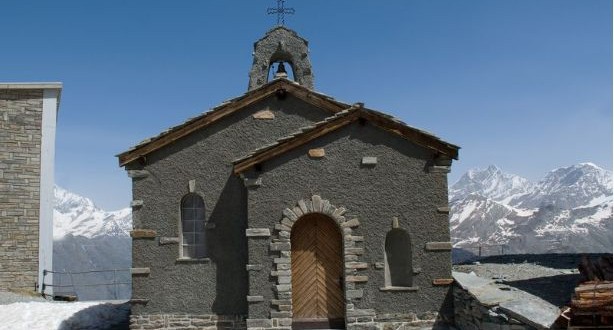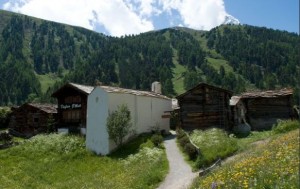Gornergrat chapel or Bernhard von Aosta on the Gornergrat is one of Zermatt’s most visited places of worship. Visitors from all over the world stop to light a candle and enjoy the soothing tranquility of this mountain sanctuary. After the hotel opened at the end of the 19th century, Sunday mass was read in the hotel’s dining room during the summer. The bishop expressed the wish for a chapel, and in 1950 construction took place. The chapel is owned by municipality, and stands at an altitude of nearly 3100 meters. The chapel is a block structure with recessed choir, double-off set roof and bell tower as a roof turret over the entrance. It is dedicated to St.Bernard. The exterior surface is rough, grey plasterwork, matching the environment. It fact, the chapel is easily overseen. It lies on the path between the hotel and mountain railway station. Anyone taking the lift from the latter to the hotel could miss the chapel all together. The interior has wooden ceiling and floor of stone slabs. The windows are without stained glass with a confessional box standing on the right of the entrance. The altarpiece consists of relief style carved wooden figures with in the center, St.Bernard of Aosta, on the left St.Maurice or patron saint of Valais, and on the right St.Theodule. A crown of alpine flowers forms the culmination of the altarpiece. The tabernacle is decorated with grapevines and the altar table is made of stone slabs with a cross. At this unique beautiful chapel, several thousand memorial candles are lit every year.
Zmutt chapel or Heilige Katharina von Alexandrien is a gorgeous small white chapel which is more than 500 years old. This place is worth a visit on the leisurely walk from Zermatt to Zmutt. The hamlet of Zmutt lies a short hour’s walk south-west of Zermatt at an altitude of 1936 meters. In the old dialect of Zermatt, a “Mutt” is rounded summit on a rocky slope. In addition to the “White House” from the year 1595, the hamlet has a rectangular baroque chapel with a recessed choir and a small bell tower over the entrance. It is dedicated to St.Catherine of Alexandria, the second patron saint of Valais, and is a place of calm that the shepherds of the region liked to visit for their prayers. They year 1727 can be seen on the sun-burned entrance doors, and probably indicates the year of construction. The nave with its two windows to the south has a wooden ceiling, while the choir has a type of groined vault made of stone that ends in a circle. The small baroque altar with the chapel saint has been kept simple,e the title figure framed by two plain pillars without ornamentation. St.Catherine is portrayed with a sword and a broken wheel, because the wheel broke during her execution. She is flanked by two female figures with the palm branch of martyrs. Since the attributes are missing, we can unfortunately no longer say which saints they represent. The pinnacle contains the mater dolorosa. Depictions of the Stations of the Cross hang on the walls of the nave. The inscriptions are in a distinctive form of German which is an unusual style.


